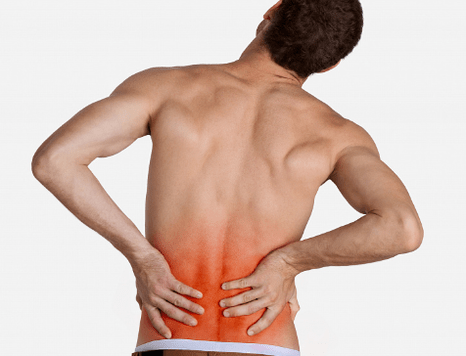Lumbar osteochondrosis of the spine is deformed in the lumbar region.The disease affects discs between the vertebrae, cartilage tissues, spine roots and nerve fibers and causes back pain.
Reasons

The main cause of the disease is the incorrect distribution of the muscle bone load.Usually this occurs when you walk in high heels, wearing a bag on one side, with unpleasant poses in a dream or sitting work.Elderly people at risk, pregnant, just born, professional athletes and office workers.
Other causes of lumbar osteochondrosis:
- injuries, bruises, arms fracture, legs, spine;
- damage to the organs of the muscle bone;
- gastrointestinal diseases that provoke the lack of beneficial substances;
- body tension at longer load;
- psychoemotic disorders;
- violation of blood flow in the spinal column;
- Inflammation of the muscle bone system;
- infections of internal organs and vertebrae;
- The stiffness of the joints, the displacement of the discs;
- protrusion and vertebral hernia;
- severe intoxication;
- metabolic disorders;
- curvature of posture;
- sedentary lifestyle;
- dehydration;
- unbalanced diet;
- Deficiency of calcium and oxygen;
- Overweight;
- bad habits;
- age -related changes;
- joint diseases.
Symptoms of lumbar osteochondrosis
The intensity and nature of the symptoms depend on the stage of the disease.The faster the patient finds the signs of lumbosacral osteochondrosis, the more effective the treatment will be.
General symptoms:
- Severe pain at the bottom of the back that can give the legs, the internal organs of the abdomen and the internal organs of the pelvis;
- pain in the kidneys and sacrum;
- Fatigue and stress in the lower and sacred stages of the spine;
- difficulties of movement, walking, willingness and body twists and body;
- Periodic background in the back part;
- Fatigue after less load;
- Crunch in the back, mobility violation, pain in a relaxed condition;
- numbness of the limbs;
- cramps and cramps in the muscles;
- dizziness;
- weakness and loss of strength;
- Reducing muscle tone and sensitivity.
In men and women, the manifestation of lumbar osteochondrosis may be different.Men may have problems with efficiency.Women often suffer pain during the pelvis.If the deformed spine is unable to fully support the back, the uterus and the appendices will experience additional loads and sometimes move in a normal physiological position.
Varieties
Classification of osteochondrosis of the lumbar spine consists of many types of disease.It is distinguished by the type of pain syndrome:
Lumbago- Acute symptom.This is expressed by sharp rogues and inability to mobility.It occurs with muscle cramps, injuries, discs and nerve roots.
Lumbalgia- This is characterized by the long-term pain caused by the hernia, protrusions, spondylarthrosses, ligaments and other disorders caused by the muscle bone system.
Sciatica- Huge pain syndrome in the Eradiri Lumbosacral class in the pool.Pain is concerned with the sciatic nerve, prevents the body from normal bending and extending, preventing me from sitting and standing painlessly.
Discogenic lumbar osteochondrosis and radiculopathy can also be distinguished.
Discogenic lumbar osteochondrosisThis is accompanied not only by the sore back, but also by the legs, buttocks, hips and abdomen at the bottom of sensitivity and numbness.Occasionally, body temperature rises, weakness, urinary tract incontinence, the patient loses weight.
RadiculopathyExpressing numbness of nerve roots and decreasing the capabilities of the human engine.Signs - tingling or pain in the entire lower body, damaged reflexes, reduction of muscle tone and joints of the limbs.
Stages of the development of lumbar osteochondrosis
Doctors track the dynamics of pathology in four stages:
- First- The symptoms are almost invisible - they are diagnosed in an X -try.The stage begins with pathological processes, in the expedient cavity of the excessive plate and microcraction of the fibrous ring.
- The second- The height of the intervertebral discs is reduced, which places the vertebrae tightly.This causes the vertebrae to slip and displacement, which is accompanied by pain during movements.
- The third- Stiffness, instability, body numbness in coccyx, lower back and sacrum.This can be explained by protruding vertebrae, proprusions, joint dislocations and spinal joint dislocations.
- Fourth- The most severe degree.The functions of the spinal column are spoiled and the growth of bones (osteophytes) is formed.Growers can pinch the nerves or damage the integrity of the vertebrae.
The consequences of lumbar osteochondrosis
- Excessive accumulation of salt in the body;
- the formation of hernia, protrusion, prolapse of vertebrae and discs;
- chronic radiculitis;
- Paresis and paralysis of the legs.
Diagnosis
Lumbar osteochondrosis and other disorders of the muscle bone system can diagnose orthopedics, osteopath, neurologist, rheumatologist, hand therapist and surgeon.An accurate diagnosis can be made:
- X-radiation of the spinal column, which shows the condition of bone, cartilage and muscle tissues, as well as ligaments and tendons.
- Myelography - test of cerebrospinal fluid with paint.It is used to examine and evaluate the nerve roots of the spinal cord.
Doctors use CT and MRI for a more detailed examination.The clinic may have diagnostics.

























